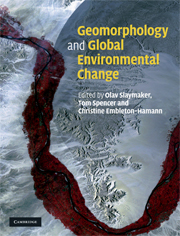Book contents
- Frontmatter
- Contents
- List of contributors
- Preface
- Acknowledgements
- List of acronyms and abbreviations
- 1 Landscape and landscape-scale processes as the unfilled niche in the global environmental change debate: an introduction
- 2 Mountains
- 3 Lakes and lake catchments
- 4 Rivers
- 5 Estuaries, coastal marshes, tidal flats and coastal dunes
- 6 Beaches, cliffs and deltas
- 7 Coral reefs
- 8 Tropical rainforests
- 9 Tropical savannas
- 10 Deserts
- 11 Mediterranean landscapes
- 12 Temperate forests and rangelands
- 13 Tundra and permafrost-dominated taiga
- 14 Ice sheets and ice caps
- 15 Landscape, landscape-scale processes and global environmental change: synthesis and new agendas for the twenty-first century
- Index
13 - Tundra and permafrost-dominated taiga
Published online by Cambridge University Press: 05 July 2015
- Frontmatter
- Contents
- List of contributors
- Preface
- Acknowledgements
- List of acronyms and abbreviations
- 1 Landscape and landscape-scale processes as the unfilled niche in the global environmental change debate: an introduction
- 2 Mountains
- 3 Lakes and lake catchments
- 4 Rivers
- 5 Estuaries, coastal marshes, tidal flats and coastal dunes
- 6 Beaches, cliffs and deltas
- 7 Coral reefs
- 8 Tropical rainforests
- 9 Tropical savannas
- 10 Deserts
- 11 Mediterranean landscapes
- 12 Temperate forests and rangelands
- 13 Tundra and permafrost-dominated taiga
- 14 Ice sheets and ice caps
- 15 Landscape, landscape-scale processes and global environmental change: synthesis and new agendas for the twenty-first century
- Index
Summary
Permafrost regions: a global change ‘hotspot’
Permafrost is defined as any subsurface material that remains frozen continuously for at least two consecutive years. The seasonally thawed layer above is known as the ‘active layer’. The permafrost regions occupy about 25% of the Earth's land area (Zhang et al., 2000), mostly situated in the tundra and taiga zones of the northern hemisphere. The distribution of permafrost is usually represented as a series of concentric zones in which permafrost is continuous (underlies more than 90% of surface), discontinuous (50–90%) and sporadic (less than 50%) (Brown et al., 1997) (Fig. 13.1). Permafrost occupies 85% of Alaska, more than 60% of Russia and 50% of Canada. Four million people are living in circumarctic/subantarctic regions, including 10% belonging to indigenous communities such as the Inuit, Sami (Lapps) and Chukchi (Bogoyavlenskiy and Siggner, 2004). Human concentrations are particularly important in northern Russia, with cities of over 100 000 inhabitants and large river ports (Fig. 13.2).
In circumarctic regions, most of the current and potential environmental and socioeconomic impacts of global warming are associated with permafrost thawing though surprisingly, as stressed by Nelson et al. (2002), much of the literature treating geohazards, social science and policy issues in polar regions fails to address issues related to permafrost adequately. However, an unprecedented research effort is being carried out among the multidisciplinary community involved in permafrost science under the auspices of the International Permafrost Association (IPA). Permafrost observations are internationally coordinated within the Global Terrestrial Network for Permafrost (Brown et al., 2000b; Romanovsky et al., 2002). Predictive modelling of permafrost behaviour is being developed, based on climatic scenarios from general circulation models (GCMs), and results from modelling are used in IPCC and ACIA assessment reports (IPCC, 2001a, 2001b, 2007a; ACIA, 2005). Frozen ground was listed by the International Union of Geological Sciences (IUGS) on its list of ‘geoindicators’ to be used to detect and assess environmental changes over relatively short periods (Berger and Iams, 1996).
- Type
- Chapter
- Information
- Geomorphology and Global Environmental Change , pp. 344 - 367Publisher: Cambridge University PressPrint publication year: 2009
- 3
- Cited by



